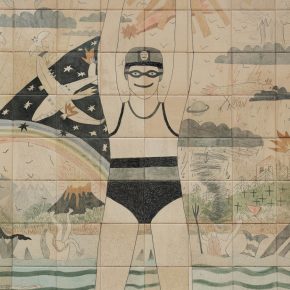Studio Conversations
Our artist community contains a mix of experience and skills working across a broad range of sculptural practice. To gain an insight into this diverse range of activity Mihaela Coman, our current SGSAH intern has visited many of the artists working at ESW to discuss their ideas and work.
Mihaela Coman, artist and PhD student at Edinburgh College of Art, started these series of interviews during her Scottish Graduate School for Art & Humanities placement at ESW in February, March and April 2023.
“It’s a great way of unlocking the individuals thoughts on and approaches to making their work. It is also a great insight into the diversity of processes and preoccupations of ESW’s studio holders.” Daniel Brown, Curator, Research, Edinburgh Sculpture Workshop
Please, find below some of our studio conversations, each of them is rewarding and unexpectedly revealing.
Jack Brindley: “I suppose a lot of my work is following the materials at hand, so when a process becomes available, I look to use the qualities that come with those processes to show the material to its best advantage rather than trying to kind of wrestle it into submission.”
Juliana Capes: “A lot of my work is on the cusp between something that’s so beautiful and so wonderful, but also maybe disgusting or wrong.”
Hans K Clausen: “For me, objects and stories are inseparable, everything has a narrative and I think my job as an artist is to find a platform, an audience, and the purpose for sharing that in an exciting and engaging way.”
Kat Cutler-Mackenzie and Ben Caro: “We definitely treat our practice as research. In fact, we’re particularly interested in artistic approaches to art history. ”
Aurélien Froment: “I work with large quantities of material, texts and images. I am going through many stages to process that, to select and choose and to make. The computer screen is too small to see more than two images at the same time, this is why there is that big magnetic wall here, an extension of the screen, my playground.”
Andrew Gannon: “There’s just this social assumption that there is an absence that needs filling. And there’s the responsibility to fill it. People project onto me that something should go there. What happens if you mess with those norms?”
Louise Gibson: “Anything that you do as a creative person feeds back in to your practice. It’s all valuable.”
Kate Ive: “I make things and that’s the part that really interests me. I’m also a researcher, so, developing that and trying to learn all the software was a big task”
Emma Hislop: “The landscape really inspires me and how mystical it feels. The way the wind blows, you always get a sense that there’s something else. It’s the unseen that inspires me.”
Jamie King: “I have to say, my painting… I’m not very happy with it. It doesn’t bring me much joy at all. Whereas on the other hand, I find making sculptures very enjoyable. It’s a good thing to do, to engage your brain with even measuring and cutting and the whole process. I think that is very satisfying.”
Andrew Kinghorn: “My garden sculptures will make a living by their own and I’m only just a little part of their history”
Svetlana Kondakova: “I had a theme and a challenge I had set myself and I came here, at Edinburgh Sculpture Workshop
Benjamin Owen: “I’ve combined my experiences of working with education, images, film, and sculpture. I make work through music in a lot of ways: it might be physical, it might be a film, it might be gestural.”
Fiona McLachlan Powell: ” I’ve always been interested in the spaces between things, the liminal spaces, spaces between the fields and roads. There’s no real purpose for them but they’re developing their own purpose, and their scale was quite good – a short distance that is manageable to move around.”
Duncan Robertson: “I do a lot of education work with the National Galleries as well, so that needs lots of new ideas.”
Lorenzo Robertson: “I’m finding my voice. Mine is part nature and part Italian.”
Yotam Sivan: “I’m interested in how meaning forms organically through symbols and through appropriation.”
Kjersti Sletteland: “Here are lots of things that were happening around me: that building block is in my neighbourhood, these are royal buffoon, stupid politicians, a little sexual reference, and a mention of when the Black Lives Matter movement were pushing down all the statues from their pedestals.”
Oana Stanciu: “I like thinking of my body as a sculptural material that I can shape in different ways using unusual positions, objects and environments to change my appearance and turn myself into surreal creatures and characters.”
Aeneas Wilder: “I’m going to tell you something that nobody has ever said to me, in all my years, they’ve never written this: it’s a binary system.”
As these conversations happen, they will be published on the ESW website and also linked to the artists’ names on the Studio Holders’ page.




